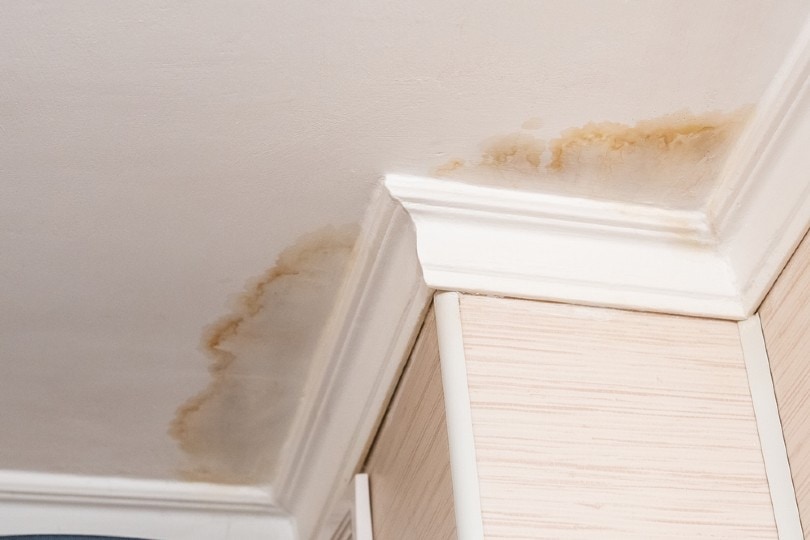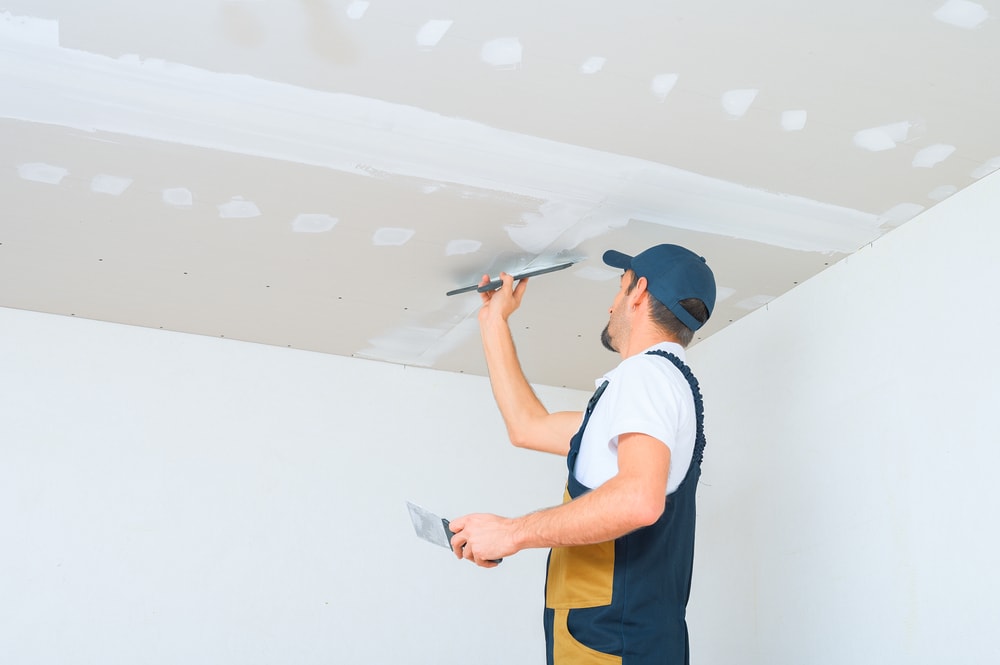Water Stains on Ceilings: How to Fix, Types of Stains & Who to Call
-
Pete Ortiz
- Last updated:

Water stains on your ceiling are unsightly and tell you that there is greater damage above. Any time you see water stains on your ceiling, you will want to evaluate the cause of the stain, repair the problem, and paint up the ceiling again so that you can’t see the stain.
To learn how to fix water stains on ceilings, keep reading.
How to Fix Water Stains on Ceilings
If you notice water stains on your ceiling, it’s important to act fast. These stains tell you that you have a problem in another part of your home that needs to be fixed. Not to mention, ceiling stains are unsightly and can ruin the entire decor of your home. Here’s how to fix water stains on your ceiling:
1. Figure Out the Root Cause and Fix It
The most crucial part of fixing water stains is to figure out the cause of the water stains. If you do not determine where the water is coming from, the stain will only come back, and you will waste a lot of money and time in the process.
Most often, water stains on the ceiling are caused by problems with your roof, radiator, or bathroom. You will want to evaluate all these potential causes until you determine the root cause. If you cannot determine where the leak is coming from, contact a professional.
After you determine the cause, you need to rectify it immediately. Most likely, you will need to contact a professional who specializes in the area that is leaking. For example, you will need a professional roofer if the roof is to blame, but you’ll need an HVAC professional if the radiator is the culprit.
It’s essential that you get Step 1 squared away before moving on to the next steps. This is the number one priority when it comes to fixing a water stain on your ceiling. If you don’t do this step correctly, all your work on the other steps will be worthless.
2. Use Bleach to Clean Stain
After the cause of the water damage is fixed, you can move on to dealing with the stain itself. Luckily, you have already tackled the hardest part of the job once you have finished Step 1. To begin cleaning the stain, you need to thoroughly clean the area.
Mix 1 cup bleach and 3 cups of warm water to create a homemade bleach solvent. This solvent will help to fade the stain, but it will, more importantly, remove mold, mildew, dust, dirt, grease, or any other item on the ceiling and prevent the paint from clinging to it.
Before applying solvent to your ceiling, make sure to add a drop cloth on the floor underneath the ceiling so that the bleach doesn’t drip onto your carpet or floor. Also, wear appropriate protective equipment.
Use a damp sponge to apply the bleach solvent directly to the stain. Rinse off any remaining bleach using a spray bottle. Wipe down any excess moisture and dampness using a clean cloth. Allow the area to dry thoroughly.

3. Prime the Stain
After you have cleaned the stain, you then need to prime it. It is imperative to prime the stain before painting it to ensure that the stain does not show through your layer of paint. Make sure that the area is thoroughly dried before grabbing your primer.
Use an oil-based and stain-blocking primer to cover the affected area. You want the primer to be as close to the ceiling’s current color as possible, though it will likely be a couple of shades darker. That is perfectly fine at this stage. How you should apply the primer depends on the texture of ceiling you have.
4. Paint the Stain
Finally, paint up the shade. Make sure that the paint you select matches the rest of the ceiling. Once again, make sure that the primer is dry before you begin painting. Apply one coat of paint, allow it to dry, then apply a second coat. Once this second coat dries, everything should look uniform again.

Types of Ceiling Stains
Even though this article is specifically about water ceiling stains, there are other common ceiling stains you can find. It’s important to know what these stains are so you can make sure that the stain you are dealing with is a water stain and not something else.
1. Water Stains
Water stains are typically dark yellow and have a deformed Halo shape. This yellow color will turn dark brown. Water stains are typically caused by leaks in your roof, HVAC system, or bathroom. You will need to target the leak before targeting the stain.
2. Mold Stains
Mold stains actually aren’t stains at all. Instead, it’s mold growth that looks like a stain. A lot of times, water stains and mold stains go hand in hand, but the two stain types are dealt with differently. Mold stains typically have green or black colors and can be found in many patterns. Since mold is caused by excess moisture, there is likely some sort of moisture issue in your home.
3. Smoke Stains
Smoke stains aren’t as common as they used to be as fewer people are smoking. Still, you can find smoke stains. Smoke stains are most often brown and have a tar-like appearance. They are a lot more consistent and uniform than water stains, resulting in a thick layer of dust spread across your ceiling. Smoke stains are most often caused by smoking.
Who to Call If You Have Ceiling Stains
If you have ceiling stains that you can’t get rid of, you will need to call a professional. Most importantly, you will want to contact a professional who specializes in the cause of the stain. For example, a mold stain may require a mold remediation specialist, whereas a water stain may require a plumber. It’s most important that you deal with the cause of the stain before moving on to the stain itself.
After you have dealt with the underlying cause of the stain, you can contact professional painters to cover up the stain. The professional painters will ensure that the stain is completely covered and that your ceiling looks uniform.
If you don’t want to spend the extra money, you can technically paint your ceiling yourself. Often, this results in uneven ceilings, but it is the more affordable option of the two. Even if you’re on a budget, we highly recommend contacting a professional to deal with the cause of the stain since this often requires heavy-duty work. Only save money on the paint.
Final Thoughts
At the end of the day, water stains are typically caused by leaks in your roof, HVAC system, or bathroom. It’s important to determine where the leak is coming from before you deal with the stain itself. Only move on to fixing and covering the stain after you have rectified the root cause.
Additionally, make sure that the stain itself is not a mold or smoke stain. These stains look different and require different cleaning tactics. You should be able to distinguish between these stain types relatively easily.
When it comes to fixing the stain, it’s most important to fix the underlying cause. Hire a professional to fix the leak and prevent it from happening again. After that, you can paint the stain yourself or hire a professional to do it for you.
- See also: Who Invented the Monkey Wrench?
Featured Image Credit: Afanasiev Andrii, Shutterstock
Contents





